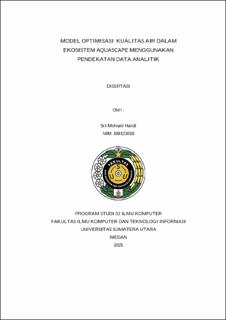Model Optimisasi Kualitas Air dalam Ekosistem Aquascape Menggunakan Pendekatan Data Analitik
Optimization Model of Water Quality in Aquascape Ecosystems Using Data Analytics Approach

Date
2025Author
Hardi, Sri Melvani
Advisor(s)
Mahyuddin
Efendi, Syahril
Zarlis, Muhammad
Metadata
Show full item recordAbstract
Dissolved Oxygen (DO) is a key parameter in maintaining the ecological balance of aquascapes, playing a crucial role in sustaining the life of aquatic flora and fauna as well as serving as a primary indicator of water quality. Precise optimization of DO levels is essential to create a stable and healthy aquascape environment. This study aims to develop an optimal water quality model for aquascapes using the Multivariate Adaptive Regression Splines (MARS) algorithm. Feature selection was conducted using three correlation methods—Pearson, Spearman, and Kendall—to analyze the relationship between variables and DO. Variables with the highest correlation coefficients were selected as input predictors for the MARS model, with predictor variations applied to each tank. The model was tested across three tanks using different combinations of Basis Function (BF), Maximum Interaction (MI), and Minimum Observation (MO) parameters, and the best model was determined based on the lowest Generalized Cross Validation (GCV) value. The results demonstrated excellent performance in all tanks (R² approaching 1, low MSE (0.0012-0.0244), and minimum GCV((0-0,0001)). An F-test (ANOVA) yielded very high F-statistic values and p-values < 0.05, indicating that the model is statistically significant in predicting DO simultaneously. The most dominant variables identified were DO Saturation and Temperature (Tanks 1 & 2) as well as Relative Conductivity (Tank 3). Compared to other algorithms such as LSTM, Bi-LSTM, and GRU, the MARS model outperformed in terms of accuracy, stability, and resistance to overfitting
